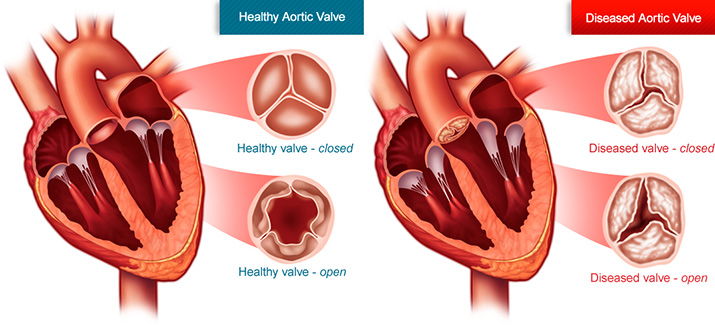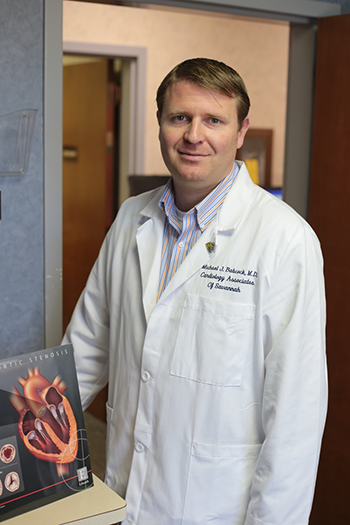What is aortic stenosis?
Heart Health

St. Joseph’s/Candler offers the minimally-invasive TAVR procedure to treat aortic stenosis
Even though it’s only about the size of your fist, your heart’s anatomy is made up of several components, including the right and left atrium, right and left ventricle and four valves.
In order to perform its main function of pumping blood to the rest of your body, all of these parts must be healthy and in working order. Damage to any of them can decrease quality of life, lead to major health events, such as heart attack or stroke, and cause death.
One of your heart’s valves that is vulnerable to damage is the aortic valve. It’s responsible for closing off the lower chamber that holds oxygen-rich blood before it’s pumped out to the body and opening to allow blood to leave the heart from the left ventricle to the aorta and on to the body.
Narrowing of this valve, called aortic stenosis, can be life threatening. Aortic stenosis restricts the blood flow from the left ventricle to the aorta and may also affect the pressure in the left atrium. The disease forces the heart to work harder to push blood through the aortic valve to your body. As a result, less oxygen-rich blood flows from the lungs to the brain and the rest of the body, which can cause symptoms.
It’s estimated about five million Americans are diagnosed with heart valve disease each year, according to the American Heart Association, with severe aortic stenosis being one of the most common ones. Approximately 50 percent of people who develop symptoms from aortic stenosis will die within an average of two years without aortic valve replacement.

“We know that once a patient with severe aortic stenosis becomes symptomatic there can be a very rapid decline and these patients need to be seen quickly,” says Dr. Michael Babcock, cardiologist with St. Joseph’s/Candler Physician Network – Cardiology Associates of Savannah. Dr. Babcock is part of the multidisciplinary team that treats aortic stenosis and other valvular issues.
Causes
Aortic stenosis can be caused by a birth defect, rheumatic fever or radiation therapy. Most often it’s related to age and is diagnosed most commonly in elderly patients. High blood pressure, high cholesterol and smoking also are associated with aortic stenosis.
Severe aortic stenosis can be caused by the build-up of calcium (mineral deposits) on the aortic valve’s leaflets (flaps of tissue). Overtime, these leaflets become stiff, reducing their ability to fully open or close. This causes the heart to work harder, and eventually, the heart gets weaker, increasing your risk of heart failure, stroke and even death.
Symptoms
Symptoms of aortic stenosis can include:
- Chest pain
- Palpitations or feeling of heaving, pounding or noticeable heartbeats
- Fatigue
- Shortness of breath
- Light-headedness, feeling dizzy and/or fainting
- Difficulty breathing during exercise
- Symptoms of aortic stenosis are sometimes misunderstood as “normal” signs of aging, Dr. Babcock says.
“The symptoms can be gradual with a long standing heart murmur and slowly developing shortness of breath, easy fatigability, chest discomfort or the feeling of passing out,” Dr. Babcock says. “Many patients attribute these symptoms to simply getting older, but if ignored, severe aortic stenosis can lead to permanent heart failure or sudden cardiac death.”
Related Article: Understanding cardiac arrest: Causes, symptoms and treatment
It’s also important to note that aortic stenosis does not always produce symptoms.
If you or a loved one notice a decline in physical activity or experience significant fatigue, talk to your primary care physician or cardiologist about the possible of reduced heart function.
Diagnosis
Aortic stenosis can be detected by your physician during a routine physical. If your doctor hears a heart murmur (an abnormal sound in your heart due to unusual blood flow), you may be asked to complete additional diagnostic testing or meet with a cardiologist to determine what the problem is and how to treat it.
Diagnostic testing can include:
- Echocardiogram
- Cardiac catheterization
- CT scan
- Lung function testing
- Carotid artery ultrasound
Treatment
The severity of your aortic stenosis will help determine the best course of treatment. Initially, mild or moderate symptoms can be managed with medication and lifestyle changes. Ultimately, the only effective treatment for severe aortic stenosis is valve replacement. This can be done through open-heart surgery or a minimally-invasive procedure called Transcatheter Aortic Valve Replacement (TAVR), which is offered at The Heart Hospital whose primary location is at St. Joseph’s Hospital. At The Heart Hospital, we have a dedicated team of specialists in the Valve Clinic that are experts in replacing valves. The first TAVR procedure at The Heart Hospital was in December 2014, and since we’ve performed 227 procedures as of mid-January 2020.
“TAVR is now approved for all patients with severe aortic stenosis, and many patients ask for it specifically as the recovery and outcomes are tremendous,” Dr. Babcock says. “Being the only regional center with fellowship-trained and board-certified interventional cardiologists, TAVR has been an amazing addition to the patient-centered treatment of valvular heart disease at The Heart Hospital.”
During the TAVR procedure, a small incision is made (most commonly in the groin area) so that the cardiothoracic surgeon and interventional cardiologist can insert a sheath (short hollow tube about the width of a pencil). The specialists then insert a
balloon into the sheath and use X-ray and echocardiography to navigate it through your vessel until it reaches your aortic valve. There, the balloon is inflated with fluid so the specialists can break open your narrowed valve.
Next, your
physicians will use the same sheath to push the transcatheter heart valve through your vessel. Fluid is again used to expand the new prosthetic valve within your diseased valve, pushing the leaflets of your diseased valve aside.
As
the balloon is deflated, your heart’s normal blood flow will cause the leaflets of your new valve to begin working. Upon waking, most patients experience immediate improvements in their breathing.
“While open heart surgery is still an option, TAVR has immediate effects in relief of the restriction of blood flow to the brain and body from severe aortic stenosis,” Dr. Babcock says. “With advanced technology, there is very quick recovery and most patients go home the next day. Patients even report feeling significantly better walking to the car the day after their valve replacement.”
To learn more about TAVR and the Valve Clinic, call 819-TAVR or ask your physician for a referral.
Coming Thursday: Learn more about the patient experience if you or a loved one are having the TAVR procedure